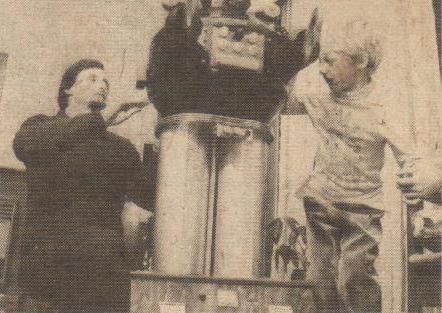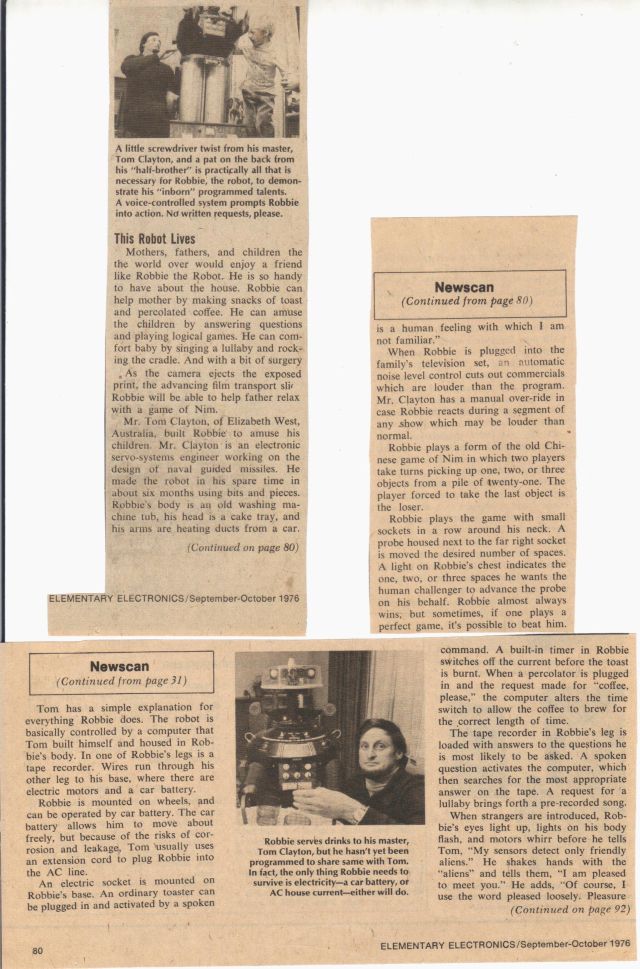Source: Elementary Electronics, Sep-Oct 1976

ELEMENTARY ELECTRONICS/September-October 1976
Newscan
A little screwdriver twist from his master, Tom Clayton, and a pat on the back from his "half-brother" is practically all that is necessary for Robbie, the robot, to demonstrate his "inborn" programmed talents. A voice-controlled system prompts Robbie into action. NO written requests, please.
This Robot Lives
Mothers, fathers, and children the the world over would enjoy a friend like Robbie the Robot. He is so handy to have about the house. Robbie can help mother by making snacks of toast and percolated coffee. He can amuse the children by answering questions and playing logical games. He can comfort baby by singing a lullaby and rocking the cradle. And with a bit of surgery As the camera ejects the exposed print, the advancing film transport slides. Robbie will be able to help father relax with a game of Nim.
Mr. Tom Clayton, of Elizabeth, West Australia, built Robbie to amuse his children. Mr. Clayton is an electronic servo-systems engineer working on the
design of naval guided missiles. He made the robot in his spare time in about six months using bits and pieces. Robbie's body is an old washing machine tub, his head is a cake tray, and his arms are heating ducts from a car.
Tom has a simple explanation for everything Robbie does. The robot is basically controlled by a computer that Tom built himself and housed in Robbie's body. In one of Robbie's legs is a tape recorder. Wires run through his other leg to his base, where there are electric motors and a car battery.
Robbie is mounted on wheels, and can be operated by car battery. The car battery allows him to move about freely, but because of the risks of corrosion and leakage, Tom usually uses an extension cord to plug Robbie into the AC line.
An electric socket is mounted on Robbie's base. An ordinary toaster can be plugged in and activated by a spoken Robbie serves drinks to his master, Tom Clayton, but he hasn't yet been programmed to share same with Tom.
In fact, the only thing Robbie needs to, survive is electricity—a car battery, or AC house current—either will do.
command. A built-in timer in Robbie switches off the current before the toast is burnt. When a percolator is plugged in and the request made for "coffee, please," the computer alters the time switch to allow the coffee to brew for the correct length of time.
The tape recorder in Robbie's leg is loaded with answers to the questions he is most likely to be asked. A spoken question activates the computer, which then searches for the most appropriate answer on the tape. A request for a lullaby brings forth a pre-recorded song.
When strangers are introduced, Robbie's eyes light up, lights on his body flash, and motors whirr before he tells Tom, "My sensors detect only friendly aliens." He shakes hands with the "aliens" and tells them, "I am pleased to meet you." He adds, "Of course, I use the word pleased loosely. Pleasure is a human feeling with which I am not familiar."
When Robbie is plugged into the family's television set, an automatic noise level control cuts out commercials which are louder than the program. Mr. Clayton has a manual over-ride in case Robbie reacts during a segment of any show which may be louder than normal.
Robbie plays a form of the old Chinese game of Nim in which two players take turns picking up one, two, or three objects from a pile of twenty-one. The player forced to take the last object is the loser.
Robbie plays the game with small sockets in a row around his neck. A probe housed next to the far right socket is moved the desired number of spaces. A light on Robbie's chest indicates the one, two, or three spaces he wants the human challenger to advance the probe on his behalf. Robbie almost always wins, but sometimes, if one plays a perfect game, it's possible to beat him.
